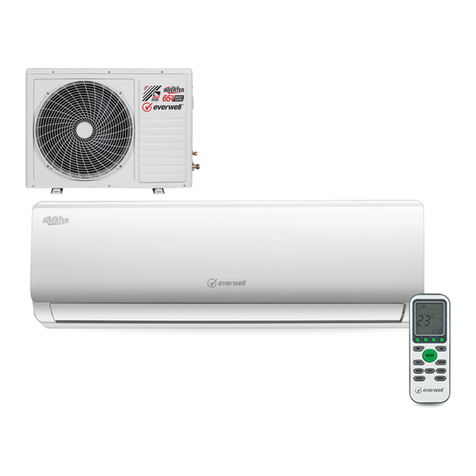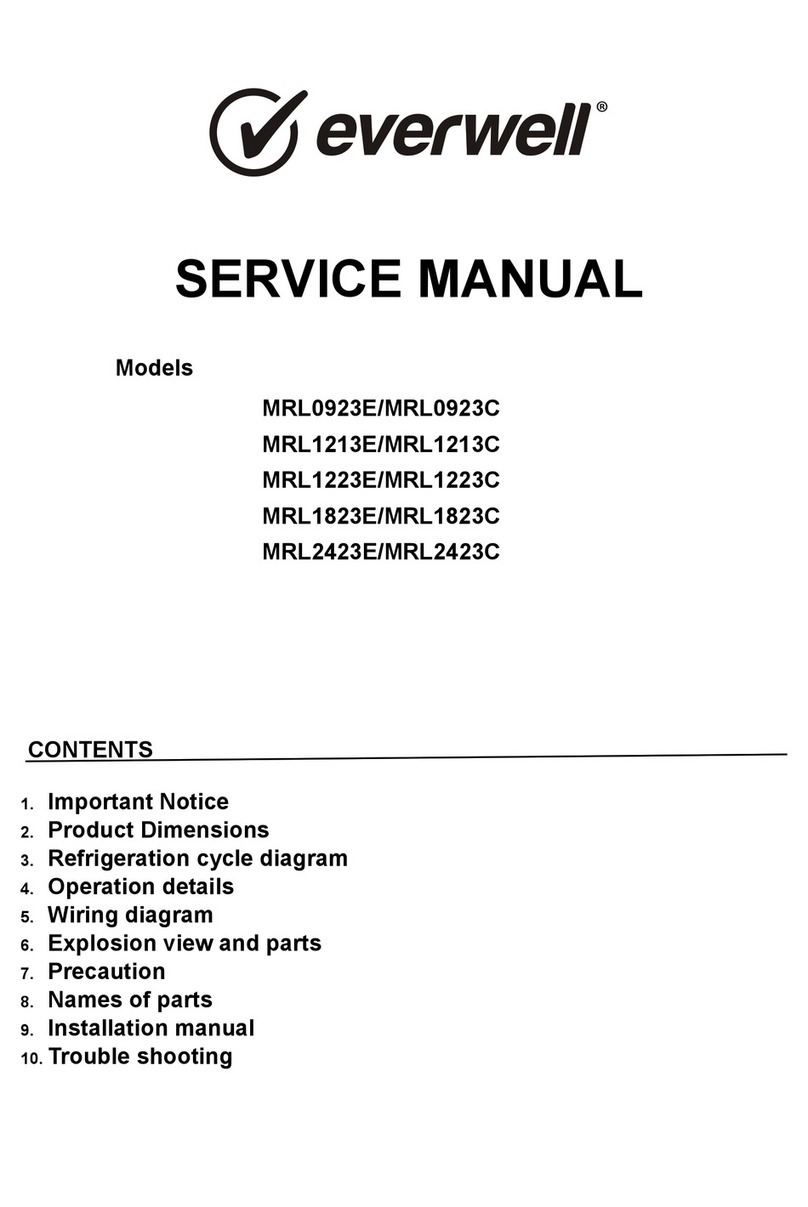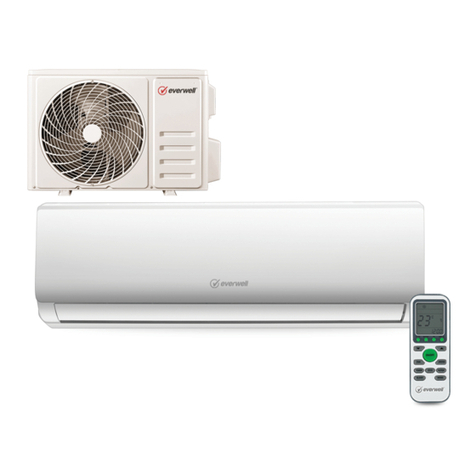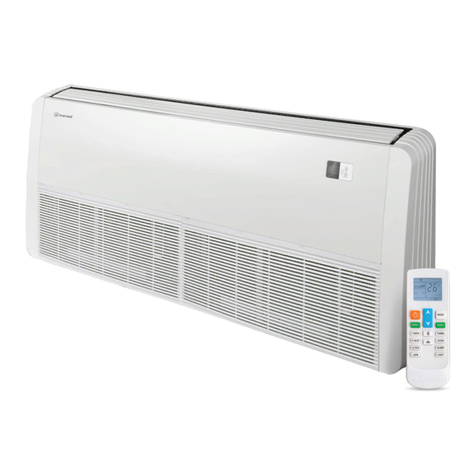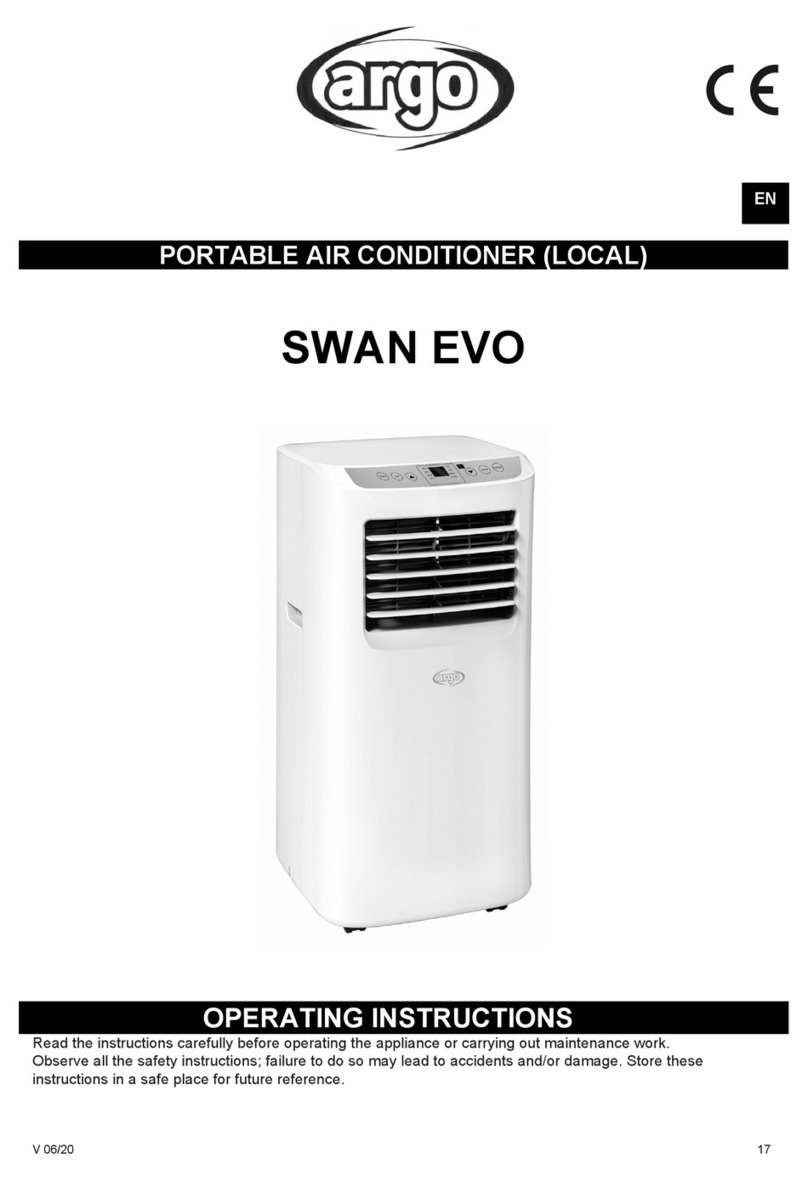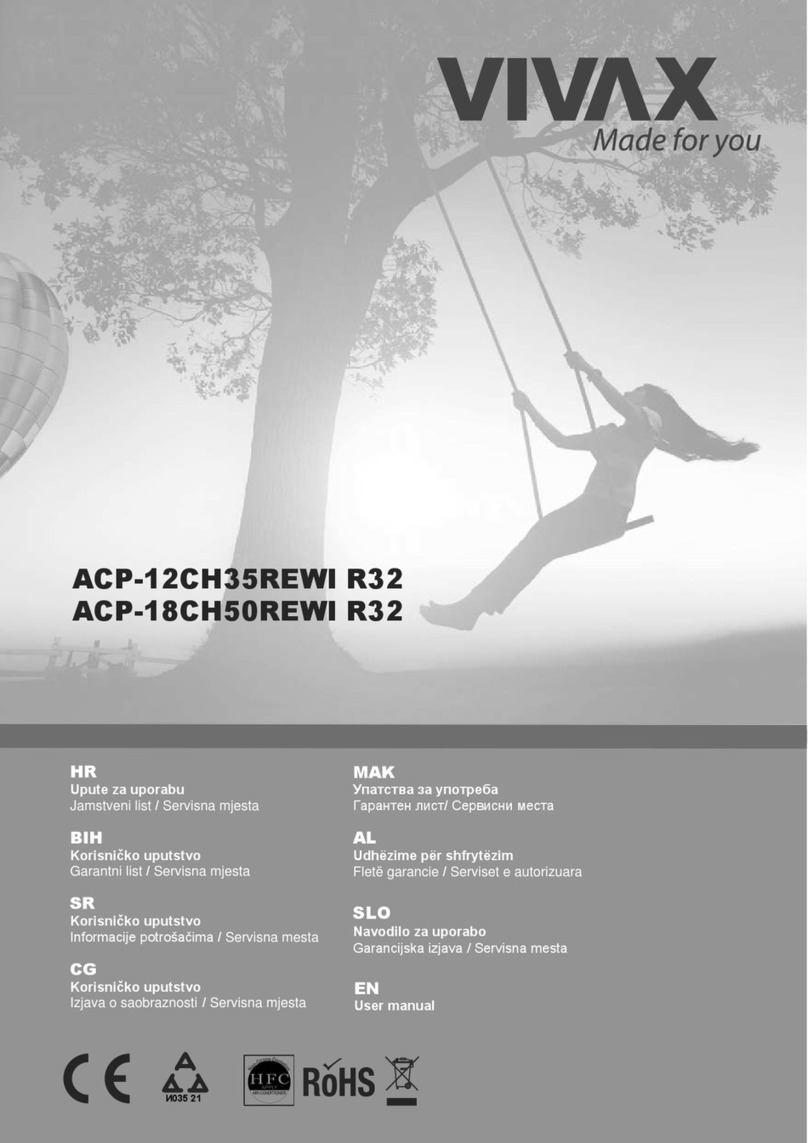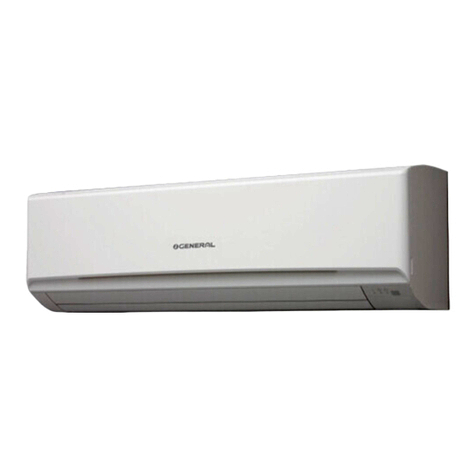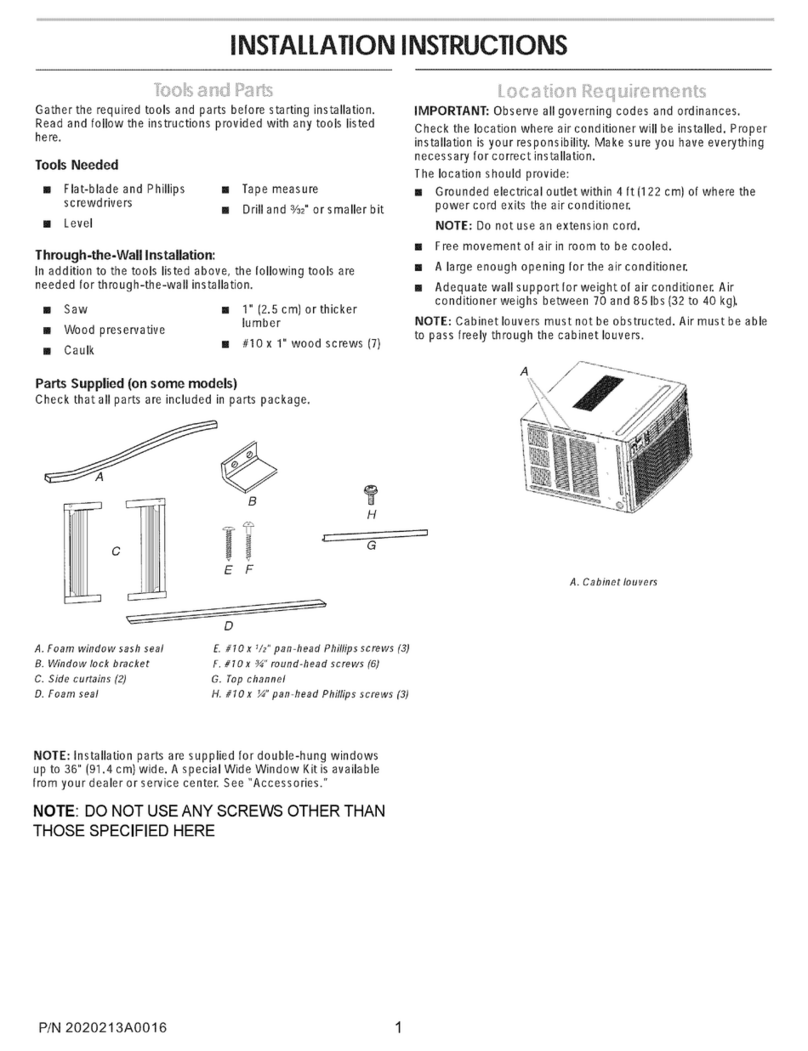Everwell MKTC1213E-16 User manual

Air Conditioner Service Manual
1
Inverter air conditioner
Service Manual
Models
MKTC1213E-16/MKTC1213C-16
MKTC1223E-16/MKTC1223C-16
MKTC1823E-16/MKTC1823C-16
MKTC2423E-16/MKTC2423C-16
MKTH1213E-16/ MKTH1213C-16
MKTH1223E-16/ MKTH1223C-16
MKTH1823E-16/ MKTH1823C-16
MKTH2423E-16/ MKTH2423C-16

Air Conditioner Service Manual
2
CONTENTS
Part ⅠTechnical Information
1. Important Notice .................................................................................3
2. Refrigeration cycle diagram ..............................................................4
3. Wiring Diagram ...................................................................................5
4. Electronic Controller Introduction ....................................................7
4.1 Electronic Controller ...................................................................7
4.2 WIFI OPERATION MAUAL .........................................................13
PART ⅡInstallation and Maintenance...................................................14
1. Notes for installation and maintenance..........................................14
2 Installation..........................................................................................21
2.1 Installation Dimension Diagram ...............................................21
2.2 Accessory ..................................................................................22
2.3 Tools ...........................................................................................22
2.4 Position ......................................................................................23
2.5 Electricity and wiring ................................................................23
2.6 IDU Installation ..........................................................................23
2.7 ODU Installation.........................................................................26
2.8 Vacuum and gas leakage test ...................................................27
2.9 Final test.....................................................................................27
3. Maintenance......................................................................................28
3.1 Failure code ...............................................................................28
3.2 Trouble shooting .......................................................................30
4. Disassembly IDU & ODU..................................................................54
4.1. IDU Disassembly ......................................................................54
4.2 ODU Assembly...........................................................................58
APPENDIX..................................................................................................69
Appendix 1 The comparison table of Celsius-Fahrenheit temperature
...............................................................................................................69
Appendix 2 The Pipe length and Gas charging .................................69
Appendix 3 Pipes Flaring.....................................................................70
Appendix 4 THERMISTOR TEMPERATURE CHARACTERISTICS .....71

Air Conditioner Service Manual
3
Part ⅠTechnical Information
1. Important Notice
This service manual is intended for use by individuals possessing adequate
backgrounds of electrical, electronic
and mechanical experience. Any
attempt to repair the appliance may result in personal injury and property
damage. The manufacturer or seller cannot be responsible for the
interpretation of this information, nor can
it assume any liability in
connection with its use.
The information, specifications and parameter are subject to change due to
technical modification or improvement
without any prior notice. The
accurate specifications are presented on the nameplate label.

Air Conditioner Service Manual
4
2. Refrigeration cycle diagram
Cooling only
Heat pump
Liquid side
2-way valve
Gas side
3-way valve
Compressor
4-way valve
Muffler
Muffler
Heat exchange
(Condenser)
Heat exchange
(Evaporator)
Check valve
Cooling
Heating
Capillary
Capillary
Compressor
Accumulator
Heat exchange
(condenser)
Heat exchange
(Evaporator)
2-way valve
Liquid side
3-way valve
Gas side

Air Conditioner Service Manual
5
3. Wiring Diagram
MODEL: MKTC1213E-16/MKTC1213C-16, MKTH1213E-16/MKTH1213C-16
INDOOR UNIT:
OUTDOOR UNIT
θ
θ
θ

Air Conditioner Service Manual
6
MODEL: MKTC1223E-16/ MKTC1223C-16, MKTC1823E-16/ MKTC1823C-16, MKTC2423E-16/ MKTC2423E-16
MKTH1223E-16/ MKTH1223C-16, MKTH1823E-16/ MKTH1823C-16, MKTH2423E-16/ MKTH2423C-16
INDOOR UNIT:
OUTDOOR UNIT
θ
θ
θ

Air Conditioner Service Manual
7
4. Electronic Controller Introduction
4.1 Electronic Controller
RT-------Room Temperature.
IPT------Indoor Pipe (Coil) Temperature.
ST------Indoor Setting Temperature.
OPT---Outdoor Pipe Temperature.
OAT---Outdoor Ambient Temperature.
ODT---Outdoor Discharge Temperature.
CRT---Compensated Room Temperature.
IDU--- Indoor unit
ODU---Outdoor unit.
Note: When AC finishing installation, because of the air ventilation and the distance of temperature test sensor to
different location of the house, the temperature for IDU PCB control need compensation.
1. Cooling mode. CRT=RT;
2. Heating mode. CRT=RT-3℃-----Split AC.
4.1.1 Auto mode
1. The set temperature can be adjusted from 16-31℃ on auto mode, the operation of fan speed and vane position
according to preset.
2. Operation
When unit set to auto mode, it will work on cooling, heating or fan mode totally according to Δt --the temperature
difference between RT and ST shown as table:
Mode
Δt=RT-ST
COOLING
Δt >1℃
FAN
-1℃≤Δt≤1℃
HEATING
Δt <-1℃
4.1.2 Cooling mode
1. Temperature control :16-31℃, and the operation of fan speed and vane position according to preset.
2. Compressor and process control
1). When RT-ST≥0.5℃, the compressor starts up working, AC operates as customer preset;
2). When
a. RT-ST≤-3℃ and compressor keeps 2 min continuously; or
b. RT-ST≤-2℃ and compressor works in lowest frequency for 5 min continuously; or
c. RT-ST≤-1℃ and compressor works in lowest frequency for 10 min continuously,
The compressor stops operation.
3). The compressor frequency control: Based on relation of RT & ST, and the changing speed of RT.
4). The compressor will also stop working while unit:
a. switched off.
b. under protection.
c. changed to fan mode.
5). Under normal operation, the compressor can be stopped by program only working after 7 min once it starts up.
6). In the process of unit operation, once the compressor ceased, it should be 3 min delay for the next procedure.
3. ODU Fan motor control:
1). While unit:
a. switched off.
b. under protection.
c. to the set temperature.
After compressor ceased, the fan motor stops working according to the temperature of OPT and OAT, the max delay
for the motor should be less than 160s.
2). When switch on unit on cooling mode, ODU fan motor will delay 5s after compressor starts up.
4. When ODU failure or stops for protection, IDU works as preset.
5. Anti-frosting protection
Control the unit operation frequency and the frequency changing rate to achieve anti-frosting protection.

Air Conditioner Service Manual
8
1). Frequency Slowly Increasing(FSI):
a. If 6℃≤IPT<7℃, the frequency increasing rate is 1Hz/60s, slowly increasing operation speed.
b. When IPT≥7℃, unit quit from protection.
2). Frequency Limitation:
If 5℃≤IPT<6℃, the compressor frequency forbidden to increase
3). Normal Frequency Decreasing (NFD):
If 3℃≤IPT<4℃, the frequency decreasing rate is 8Hz/90s, until to the lower frequency limit.
4). Fast Frequency Decreasing (FFD):
If 2℃≤IPT<3℃, the frequency decreasing rate is 16Hz/90s, until to the lower frequency limit.
5). Unit stop:
a. When IPT<1℃for 3min continuously, unit stops working for anti-defrosting protection.
b. While IPT>6℃, and the unit stopped for 3 min already, can the unit recover to operation.
0℃
-1℃
-2℃
-3℃
RT-ST
COMPRESSOR
OUTDOOR FAN
INDOOR FAN
160S
160S
10min.
5min. 2min.
ON OFF
5s
0.5℃
≥ 7min.
≥3min.
4.1.3 Dry mode
1. Temperature control: 16~31℃.
Fan speed: low
Vane blade position: as customer preset
2. When ODU failure or stops for protection, IDU works as preset.
3. Failure protection: as cooling mode.
4. Energy saving and sleep mode: Invalid.
4.1.4 Heating mode
1. Temperature control: 16-31℃.
2. Compressor and process control.
1). When ST-CRT≥0.5℃, the compressor starts up working, AC operates as customer preset;;
2). When
a. ST-CRT≤-3℃ and compressor keeps 2 min continuously; or
b. ST-CRT≤-2℃ and compressor works in lowest frequency for 5 min continuously; or
c. RT-CRT≤-1℃ and compressor works in lowest frequency for 10 min continuously,
The compressor stops operation.
3). The compressor frequency control: Based on relation of RT & ST, and the changing speed of RT.
4). The compressor will also stop working while unit:
a. switched off.
b. under protection.
c. changed to fan mode.
5). Under normal operation, the compressor can be stopped by program only working after 7 min once it starts up.
6). In the process of unit operation, once the compressor ceased, it should be 3 min delay for the next procedure.
3. IDU time delay: When compressor stops or unit switches off while in heating mode, IDU fan motor will work for a
few seconds more to prevent overheat.

Air Conditioner Service Manual
9
4: ODU Fan motor control:
1). While unit:
a. To be switched off
b. Under protection.
c. To the set temperature
After compressor ceased, the fan motor stops working according to the temperature of OPT and OAT, the max delay
for the motor should be less than 160s.
2). When switch on unit on heating mode, ODU fan motor will delay 5s after compressor starts up
3). in the process of defrosting, the fan motor will stop operation 48s delay after compressor stopped.
4). defrosting finish, the compressor stops operation, the fan motor will start working simultaneously.
5. 4-way valve control
1). On Cooling/Dry/Fan mode,4-way valve: OFF, when unit switched on heating mode,4-way valve: ON.
2). When heating mode switched off, or changed from heating to other modes, the 4-way valve will be OFF 2 min
delay after the compressor stops working.
3). Unit stops working caused by any kind of protection, the 4-way valve will be OFF 4 min delay.
4). In the process of defrosting, 4-way valve will be OFF 43s delay after compressor stopped.
5). When defrosting finish, the compressor stops operation, 4-way valve will be ON after 43s delay.
0 ℃
-1℃
-2℃
-3℃
ST-CRT
COMPRESSOR
OUTDOOR FAN
INDOOR FAN
2 min.
10 min.
5min.
≥ 7min.
160S
160S
≥3min.
4-way VALVE
5s
ON OFF
0.5℃
≤2min. ≤2min.
6. Defrost
Note: t1: compressor continuous works time.
t2: AC unit operation first time going to defrost circle.
t3: compressor accumulated working time (when OPT≤3℃ unit starts to count the time for t3).
When AC unit working to:
t1≥t2, or
t3≤t1<t2.
and also the temperature (related to OAT & OPT) tested 3 min continuously meets for defrosting.
Defrosting start up: Compressor stops working, and re-starts to working after 50s delay;
Conditions for quitting defrosting
After defrosting 60s, and OAT≥12℃; or
OAT<-5℃, and OPT ≥8℃ for 80s continuously; or
The defrosting for 10 min.
When AC meet any of condition a, b or c, defrosting finish.
COMPRESSOR
ON
OUTDOOR FAN
4-way VALVE
OFF
50S 50S
43S
48S Defrosting max time
43s

Air Conditioner Service Manual
10
Defrosting end off: Compressor stops working, and re-starts to working after 50s delay;
7. Cold air prevention:
This function intends to prevent cold air from being discharged when the heating operation starts up
1). IDU fan motor cold air prevention
.When RT<24℃:
a. If ITP>31℃ while compressor works for 5 min, fan motor will work according to preset fan speed.
b. If IPT≤31℃, fan motor stops working while compressor operation within 2min, if IPT≥27℃, fan motor works in low
speed 2 min, then change to preset speed.
When RT≥24℃:
a. Within 2 min after compressor start up working, once IPT>27℃, fan motor will change to preset speed.
b. After compressor starts working 2 min, fan motor change to preset speed directly.
2). Vane blade operation for cold air prevention.
If the vane works on status of non-swing: While IPT increase to a special degree, the vane blade will change the position
to:
Default angle; or
Previous position; or
Customer preset.
The above operation can work one time only, when compressor stops working, the unit will once again inspect the function.
If the vane works on swing: When IDU quits from cold air prevention, vane operate as preset.
8. “8℃” Heating
When function effective, it will make sure the room temperature not lower than 8℃, once room temperature lower
than 8℃,unit works on heating mode.
4.2.5 Fan mode
1. The temperature setting: 16~31℃,
Fan speed and vane position: as preset. The function for remote controller 58E only.
2. For above function, when unit preset to be auto fan mode, the fan motor will change its operation speed based on
the temperature difference of ambient and preset temperature.
3. ODU always OFF.
4.1.6 Timer
The unit has times control, when the unit meet the timer preset, it will be switched on or off automatically.
TIMER ON
1). TIMER ON can be set only when the air conditioner is OFF.
2). Press TIMER on the remote control ONCE to enter time setting.
3). Press “▲” or “▼” to set the time for unit to start working.
4). Set other function as MODE, FAN SPEED, SWING etc.
5). Press TIMER ONCE AGAIN to confirm the TIME ON setting
TIMER OFF
1). TIMER OFF can be set only when the air conditioner is ON.
2). Press TIMER on the remote control ONCE to enter time setting.
3). Press “▲” or “▼” to set the time for unit to stop working.
4). Press TIMER ONCE AGAIN to confirm the TIME OFF setting
Note: In case of no selection for the time setting within 10s, the timer function will be OFF automatically.
℃
4
2
0
δt comes down
δt goes up
High fan
Mid fan
Low fan
2℃
4℃

Air Conditioner Service Manual
11
4.1.7 Sleeping mode
While AC works in sleeping mode, the light of POWER SUPPLY and SLEEP always ON, and the temperature display
will be OFF after 15s.
In this mode, the AC unit works according to the SLEEP CURVE as designed.
Sleeping mode the unit can work 10 hours continuously, after that it will quit from this mode and work as previous
presetting.
4.1.8 Emergency switch
When the EMERGENCY switch is pressed one time, COOLING mode is selected and if it pressed again within 3s,
HEATING mode selected, while press once again, the unit will be switched off.
When the remote controller out of function, batteries lost power, for example, the EMERGENCY button in the
front of indoor unit can be used for function test.
NOTE: Do not press the EMERGEMCY switch during normal operation.
4.1.9 Auto-restart function
While air conditioner is operating in one mode, all of its operation data, such as working mode, preset temperature
etc. would be memorized into IC by main PCB. If power supply cut off due to reasons and recover again, the AUTO-
RESTART function will set
synchronously and the air conditioner would work at the same mode as before.
Note: The function setting:
Within 3 min while power on unit, set the unit on cooling mode, set temperature 30℃, and mid fan speed, press the
ECO or SLEEP button 10 times within 8s, the AUTO-RESTART will be activated.
4.1.10 Protection
4.1.10.1 Overload protection
1. Overload protection for Cooling or Dry mode
1). if:
a. OPT≥62℃, unit stops working for overload protection.
b. OPT<55℃, after compressor stopped for 3 min, can the unit be started to operate.
2). When OPT≥55℃, the compressor will be frequency limited/reduced for over load protection.
3). If unit have 6 times of over load stop-working protection continuously, this protection can’t be recovered unless
press ON/OFF button, and unit will show failure code.
In the process of operation, once the compressor runs continuously more than 6 min, the counter of over load stop-
working protection will be reset to zero and start a new counting process.
The failure and times for protection will eliminate immediately once the unit to be switched off, on fan mode or
changed to be heating mode from others.
Note: If the defective failure can’t be recovered, the failure can’t eliminate even if operation mode changed.
2. Overload protection for Heating mode
1). If:
a. IPT≥62℃, unit stops working for overload protection.
b. IPT<55℃, after compressor stopped for 3 min, can the unit be started to operate.
2). When IPT≥55℃, the compressor will be frequency limited/reduced for over load protection.
3). If unit have 6 times of over load stop-working protection continuously, this protection can’t be recovered unless
press ON/OFF button, and unit will show failure code.
In the process of operation, once the compressor runs continuously more than 6 min, the counter of over load stop-
working protection will be reset to zero and start a new counting process.
The failure and times for protection will eliminate immediately once the unit to be switched off, on fan mode or
changed to be heating mode from others.
Note: If the defective failure can’t be recovered, the failure can’t eliminate even if operation mode changed.
4.1.10.2 The compressor discharge temperature protection
1. If ODT≥115℃, unit stops working for over temperature protection;
While ODT<100℃, & after compressor stopped for 3 min, the unit can be started to operate.
2. If ODT≥100℃, the compressor will be frequency limited/reduced for over temperature protection.
3. If unit have 6 times of discharge over temperature stop working protection continuously, this protection can’t
be recovered unless press ON/OFF button, and unit will show failure code.
In the process of operation, once the compressor runs continuously more than 6 min, the counter of discharge over

Air Conditioner Service Manual
12
temperature stop working protection will be reset to zero and start a new counting process.
The failure and times for protection will eliminate immediately once the unit to be switched off, or changed to fan
mode.
Note: If the defective failure can’t be recovered, the failure can’t eliminate even if operation mode changed.
4.1.10.3 The current protection
1. If the unit A/C working current more than Limited current (ILC), the compressor will be frequency limited / reduced
for over current protection.
2.When unit A/C working current more than Stopped current (ISC), AC unit stops working. Only when the compressor
stops for 3 min can the unit be recovered operation.
3. If unit have 6 times of over current stop-working protection continuously, this protection can’t be recovered
unless press ON/OFF button.
In the process of unit operation, once the compressor runs continuously more than 6 min, the counter of stop-working
protection will be reset to zero and re-start a new counting process.
Note: For different models, ILC and ISC have different programmed value.
4.1.10.4 IPM overheating protection
1. When IPM temperature TIPM≥87℃, the compressor will be frequency limited / reduced for IPM over temperature
protection.
2. When TIPM≥95℃, the AC unit stops working for AC system protection.
If TIPM<87℃,and after compressor stopped for 3 min, can the unit be started to operate.
3. If unit have 6 times of IPM over temperature stop working protection continuously, this protection can’t be
recovered unless press ON/OFF button, and unit will show failure code.
In the process of operation, once the compressor runs continuously more than 6 min, the counter of over load stop
working protection will be reset to zero and re-start a new counting process.
The failure and times for protection will eliminate immediately once the unit to be switched off, or changed to fan
mode.
Note: If the defective failure can’t be recovered, the failure can’t eliminate even if operation mode changed.
4.1.11 Complementary
4.1.11.1 Energy saving (ECO)
Function effective on Cooling and Heating mode only.
On cooling mode, the set temperature range from 26℃ to 31℃,on heating mode, from 16℃ to 25℃.
4.1.11.2 TURBO
Function effective on Cooling, Heating, Fan and Auto modes, and fan speed operates on highest.
4.1.11.3 The communication control
If ODU PCB can’t get signal feedback from IDU for 2 min continuously, AC unit stops working and shows E0 error
code as IDU/ODU communication failure.
Once the IDU & ODU communication recovery, and also the compressor stopped for 3 min already, can the unit be
recovered to operate.

Air Conditioner Service Manual
13
4.2 WIFI OPERATION MAUAL
4.2.1 The WIFI control logic
4.2.2 Download and installation
Customer can scan the QR in the user manual or from appliance APP store to download the
APP and install it in the cell phone, while installation achieved, there would be an icon as picture
created on the desktop. Register the account and add the device to system, customer can
control the air conditioner by internet or LAN.
TUYA APP
GUBEI APP
ODU
IDU PCB
IDU WIFI
module
Home
wireless
router
TCL
CLOUD
Internet
controller
TCL AC
APP
Remote
controller

Air Conditioner Service Manual
14
PART ⅡInstallation and Maintenance
1. Notes for installation and maintenance
Safety Precautions
Important!
Please read the safety of precautions carefully before installation and maintenance. The following contents are very
important for installation and maintenance. Please follow the instructions bellow.
●The installation or maintenance must accord with the instructions.
●Comply with all national electrical codes and local electrical codes.
●Pay attention to the warnings and cautions in this manual.
●All installation and maintenance shall be performed by distributor or qualified person.
●All electric work must be performed by licensed technician according to local regulations and instructions given
in this manual.
●Be caution during installation and maintenance. Prohibit incorrect operation to prevent electric shock, casualty
and other accidents.
Warnings
Electrical safety Precautions.
1) Cut off the power supply of air conditioner before checking and maintenance.
2) The air conditioner must apply specialized circuit and prohibit share the same circuit with other appliances.
3) The air conditioner should be installed in suitable location and ensure the power plug is touchable.
4) Make sure each wiring terminal is connected firmly during installation and maintenance.
5) Have the unit adequately grounded. The grounding wire can’t be used for other purposes.
6) Must apply protective accessories such as protective boards, cable-cross loop and wire clip.
7) The live wire, neutral wire and grounding wire of power supply must be corresponding to the live wire, neutral
wire and grounding wire of the air conditioner.
8) The power cord and power connection wires can’t be pressed by hard objects.
9) If power cord or connection wire is broken, it must be replaced by qualified person.
10) If the power cord or connection wire is not long enough, please get the specialized power cord or connection
wire from the manufacture or distributor. Prohibit prolong the wire by yourself.
11) For the air conditioner without plug, an air switch must be installed in the circuit. The air switch should be all-pole
parting and the contact parting distance should be more then 3mm.
12) Make sure all wires and pipes are connected properly and the valves are opened before energizing.
13) Check if there is electric leakage on the unit body. If yes, please eliminate the electric leakage.
14) Replace the fuse with a new one of the same specification if it is burnt down, don’t replace it with a cooper wire
or conducting wire.
15) If the unit is to be installed in a humid place, the circuit breaker must be installed.
Installation Safety Precaution
1) Select the installation location according to the requirement of this manual. (See the requirements in installation
part).
2) Handle unit transportation with care, the unit should not be carried by only one person if it is more than 20kg.
3) When installing the indoor unit and outdoor unit, a sufficient fixing bolt must be installed, make sure the installation
supporter is firm.
4) Ware safety belt if the height of working is above 2m.
5) Use equipped components or appointed components during installation.

Air Conditioner Service Manual
15
6) Make sure no foreign objects are left in the unit after finishing installation.
Improper installation may lead to fire hazard, explosion, electric shock or injury.
Safety precautions for Installing and Relocating the unit.
To ensure safety, please be mindful of the following precautions.
Warnings
When installing or relocating the unit, be sure to keep the refrigerant circuit free from air or substances other than the specified
refrigerant.
Any presence of air or other foreign substance in the refrigerant circuit will cause system pressure rise or compressor rupture,
resulting in injury.
When installing or moving this unit, do not charge the refrigerant which is not comply with that on the nameplate or unqualified
refrigerant.
Otherwise, it may cause abnormal operation, wrong action, mechanical malfunction or even series safety accident.
When refrigerant needs to be recovered during relocating or repairing the unit, be sure that the unit is running in cooling mode.
Then, fully close the valve at high pressure side (two-way valve). About 30-40 seconds later, fully close the valve at low pressure
side (3-way valve), immediately stop the unit and disconnect power. Please note that the time for refrigerant recover should
not exceed 1 minute.
If refrigerant recovery takes too much time, may be cause compressor overheat, resulting in injury.
During refrigerant recovery, make sure that two-way valve and 3-way valve are fully closed and power is disconnected before
detaching the connecting pipe.
If compressor starts running when the valves is open and connecting pipe is not yet connected, air will be sucked in and cause
pressure rise and then compressor overheat or gas leak, resulting in injury.
When installing the unit, make sure that connecting pipe is securely connected before the compressor starts running.
If compressor starts running when the valves is open and connecting pipe is not yet connected, air will be sucked in and cause
pressure rise and then compressor overheat or gas leak, resulting in injury.
Prohibit installing the unit at the place where there may be leaked corrosive gas or flammable gas.
If there leaked gas around the unit, it may cause explosion and other accidents.
Do not use extension cords for electrical connections. If the electric wire is not long enough, please contact a local service
center authorized and ask for a proper electric wire.
Poor connection may lead to electric shock or fire.
Use the specified types of wires for electrical connections between the indoor and outdoor units. Firmly clamp the wires so
that their terminals receive no external stresses.
Electric wires with insufficient capacity, wrong wire connections and insecure wire terminals may cause electric shock or fire.
Introduction R32, R290 air conditioner installation
Introduction to Refrigerants R32 & R290
The refrigerants used for air conditioners are environmentally friendly hydrocarbons R32 and R290. The two
kinds of refrigerants are combustible and odorless. Moreover, they can burn and explode under certain condition.
However, there will be no risk of burning and explosion if you comply with the following table to install your air
conditioner in a room with an appropriate area and use it correctly.
Compared with ordinary refrigerants, Refrigerants R32 & R290 are environmentally friendly and do not destroy
the ozone sphere and that their values of greenhouse effect are also very low.
R32/R290 air conditioner installation area requirement
m1=(4m3)×LFL, m2=(26m3) ×LFL, m3=(130m3) ×LFL
Where LFL is the lower flammable limit in kg/m3, R290 LFL is 0.038kg/m3, R32 LFL is 0.306kg/m3.
For the appliances with a charge amount m1<M<m2:
The maximum charge in a room shall be in accordance with the flowing: Mmax=2.5×(LFL)(5/4) ×h0×A1/2
The required minimum floor area Amin to install an appliance with refrigerant charge M(kg) shall be in
accordance with following: Amin= (M/ (2.5 x (LFL)(5/4) x h0)) 2
Where:
Mmax is the allowable maximum charge in a room, in kg;
M is the refrigerant charge amount in appliance, in kg;
Amin is the required minimum room area, in m2;

Air Conditioner Service Manual
16
A is the room area, in m2;
LFL is the lower flammable limit, in kg/m3;
h0 is the installation height of the appliance, in meters for calculating Mmax or Amin, 1.8 m for wall mounted;
Table GG.1 - Maximum charge (kg)
Category
LFL
(kg/m3)
h0
(m)
Floor area (m2)
Maximum charge (kg)
4
7
10
15
20
30
50
R290
0.038
0.6
0.05
0.07
0.08
0.1
0.11
0.14
0.18
1
0.08
0.11
0.03
0.06
0.09
0.2
0.3
1.8
0.15
0.2
0.24
0.29
0.34
0.41
0.53
2.2
0.18
0.24
0.29
0.36
0.41
0.51
0.65
R32
0.306
0.6
0.68
0.9
1.08
1.32
1.53
1.87
2.41
1
1.14
1.51
1.8
2.2
2.54
3.12
4.02
1.8
2.05
2.71
3.24
3.97
4.58
5.61
7.254
2.2
2.5
3.31
3.96
4.85
5.6
6.86
8.85
Table GG.2 - Minimum room area (m2)
Category
LFL
(kg/m3)
h0
(m)
Charge amount (M) (kg)
Minimum room area (m2)
R290
0.038
0.152kg
0.228kg
0.304kg
0.456kg
0.608kg
0.76kg
0.988kg
0.6
/
82
146
328
584
912
1514
1
/
30
53
118
210
328
555
1.8
/
9
16
36
65
101
171
2.2
/
6
11
24
43
68
115
R32
0.306
1.224kg
1.836kg
2.448kg
3.672kg
4.896kg
6.12kg
7.956kg
0.6
/
29
51
116
206
321
543
1
/
10
19
42
74
116
196
1.8
/
3
6
13
23
36
60
2.2
/
2
4
9
15
24
40
Caution:
Please contact the nearest after-sale service center when maintenance is necessary. At the time of
maintenance, the maintenance personnel must strictly comply with the Operation Manual provided by the
corresponding manufacturer and any non-professional is prohibited to maintain the air conditioner.
It is necessary to comply with the provisions of gas-related national laws and regulations.
It is necessary to clear away the refrigerant in the system when maintaining or scrapping an air
conditioner.
When filling the combustible refrigerant, any of your rude operations may cause serious injury or injuries
to human body or bodies and object or objects.
A leak test must be done after the installation is completed.
It is a must to do the safety inspection before maintaining or repairing an air conditioner using combustible
refrigerant in order to ensure that the fire risk is reduced to minimum.
1) Installation Safety
Installation Safety Principles
Site Safety
Open Flames Prohibited Ventilation Necessary

Air Conditioner Service Manual
17
Operation Safety
Open Flames Prohibited
Mind Static Electricity Must wear protective clothing and anti-static gloves Don`t use mobile phone
Installation Safety
Caution:
The installation should be in a well-ventilated condition location.
When you installing or maintaining an air conditioner using Refrigerant R32/R290, the location should be
free fire from open or any other goods temperature higher than 370℃ for R290/548℃for R32 which easily
produces open fire include welding, smoking, drying oven.
When installing an air conditioner of R32/R290, it is necessary to take appropriate anti-static measures
such as wear anti-static clothing and gloves.
It is necessary to choose the location for installation or maintenance where in the air inlets and outlets of
the indoor and outdoor units should be not surrounded by obstacles or close to any heat source or
combustible and/or explosive environment.
If the indoor unit suffers refrigerant leak during the installation, it is necessary to immediately turn off the
valve of the outdoor unit and all the personnel should go out till the refrigerant leaks completely for 15
minutes. If the product is damaged, it is a must to carry such damaged product back to the maintenance
station and it is prohibited to weld the refrigerant pipe or conduct other operations on the user’s site.
It is necessary to choose the place where the inlet and outlet air of the indoor unit is even.
It is necessary to avoid the places where there are other electrical products, power switch plugs and
sockets, kitchen cabinet, bed, sofa and other valuables right under the lines on two sides of the indoor unit.
Special tools:
Tool Name
Requirement(s) for Use
Mini Vacuum Pump
It should be an explosion-proof vacuum pump; can ensure certain precision and its
vacuum degree should be lower than 10Pa.
Filling Device
It should be a special explosion-proof filling device; have certain precision and its
filling deviation should be less than 5g.
Leak Detector
It should be calibrated regularly; and its annual leak rate should not exceed 10g.
Concentration
Detector
A) The maintenance site should be equipped with a fixed-type combustible
refrigerant concentration detector and connected to a safeguard alarm system;
its error must be not more than 5%.
B) The installation site should be equipped with a portable combustible refrigerant
concentration detector which can realize two-level audible and visual alarm; its
error must be not more than 10%.
C) The concentration detectors should be calibrated regularly.
D) It is necessary to check and confirm the functions before using the concentration
detectors.
Refrigerant Leak Detector
Appropriate Installation
Location
The left picture is the schematic diagram of a refrigerant leak
detector.

Air Conditioner Service Manual
18
Pressure Gauge
A) The pressure gauges should be calibrated regularly.
B) The pressure gauge used for Refrigerant 22 can be used for Refrigerants R290
and R161; the pressure gauge used for R410A can be used for Refrigerant 32.
Fire Extinguisher
It is necessary to carry fire extinguisher(s) when installing and maintaining an air
conditioner. On the maintenance site, there should be two or more kinds of dry
powder, carbon dioxide and foam fire extinguishers and that such fire extinguishers
should be placed at stipulated positions, with eye-catching labels and in handy
places.
Maintenance
1). Inspections before maintenance.
(1) Inspection of maintenance environment
There should be no leaked refrigerant in the room before operation.
It is only allowed to operate in a room which meets the area requirement on the nameplate.
It is necessary to make the room keep a continuous ventilation state at the time of maintenance.
The room in the maintenance should be free from fire or welding, smoking, drying oven or any other goods
temperature higher than 370℃ (R290)/548℃ (R32) which easily produces fire.
During the maintenance, it is necessary to ensure that any person’s any mobile phone or any electronic
product with radiation in the room is powered off.
The maintenance area should be equipped with a drying powder or carbon dioxide fire extinguisher and
that such fire extinguisher can work.
(2) Inspection of maintenance equipment
Check the maintenance equipment is applicable to the refrigerant or not and it is only allowed to use the
professional equipment recommended by the air conditioner manufacturer.
Check the refrigerant leak detector whether has been calibrated. The set maximum alarm concentration
of the refrigerant leak detector should not exceed 25% of the lower explosion limit (LEL), the refrigerant
leak detector must be working during maintenance.
2) Inspection of air conditioner
It is necessary to ensure that the air conditioner is in reliable ground connection before maintenance.
Make sure powered supply to air conditioner is off. Before maintenance, it is necessary to cut off the
power and discharge the capacitor power which used in the air conditioner. If it is a must to need the
power supply during the maintenance, it is necessary to do ongoing leak detection at the most dangerous
position/point in order to avoid potential danger.
Check the warning labels on the air conditioner whether are in good condition. It is necessary to replace
the damaged or smeared warning labels.
3). Leak inspection before maintenance
Before maintenance, use the leak detector or concentration detector (pump-type) recommended by
the corresponding air conditioner manufacturer to check the air conditioner leak or not.
Warning
If leak may exist, it is necessary to move all the fire out from the site or extinguish fire and then
immediately shut off the air conditioner. Meanwhile, it is necessary to make sure well-ventilated.
4). Safety principles during the maintenance
At the time of maintenance, it is necessary to ensure well-ventilation on the site.
It is prohibited to use fire including welding, smoking or other purposes. It is prohibited to use mobile
phones.

Air Conditioner Service Manual
19
At the time of maintenance, if the relative humidity is lower than 40%, it is necessary to wear anti-
static clothing and gloves.
If the combustible refrigerant is found leaking during the maintenance, it is a must to immediately take
forced ventilation and plug up the leak source.
If the product is damaged to the extent that it is a must to open the refrigerating system for
maintenance, it is a must to carry the product back to the maintenance station for maintenance. (It is
prohibited to weld the refrigerant pipe and do other operations on the user’s site.)
It is necessary to return the air conditioner to its initial state if it is necessary to provide visiting service
again due to lacking spare part during the maintenance. Moreover, it is a must to ensure that the
refrigerating system is in secure ground connection.
If it is necessary to provide visiting service with a refrigerant cylinder, the volume of refrigerant filled in
such refrigerant cylinder should not exceed the stipulated value. When such cylinder is stored in a
vehicle or placed on the installation or maintenance site, it is necessary to place it vertically and
securely and keep it away from any place where there is any heat source, combustion source,
radiation source or electrical equipment.
5). Requirements for the site of maintenance-station
The maintenance location should be well-ventilated, with leveled ground and not in a basement.
The maintenance should be divided into welding and non-welding areas both of which should be
labeled clearly. There should be a certain safety distance between the two areas. The maintenance
location should be equipped with ventilating and air-exhausting equipment to prevent the refrigerant
gas from aggregating.
It is necessary to provide some relevant instruments such as combustible refrigerant leak detector
and have a leak detecting instrument management system. It is necessary to confirm that the leak
detector can work normally before maintenance.
The main power switch should be set outside the maintenance location and equipped with protective
(explosion-proof) devices.
It is necessary to provide firefighting devices such as dry powder or carbon dioxide fire extinguisher
appropriate for extinguishing the electrical fire and keep such firefighting devices in a usable
condition.
Temporary wires and sockets are prohibited on the maintenance location.
6). Requirements for fill the refrigerants
It is necessary to use nitrogen to clear the cyclic system before operating the refrigerating system and
vacuumize the outdoor unit for 30 minutes at least.
It is necessary to ensure that there is no cross contamination among different refrigerants when the
refrigerant filling device is used. The total length including the refrigerant pipeline should be as short
as possible in order to reduce the residual refrigerant inside such pipeline.
It is necessary to vertically place the refrigerant storage tanks.
It is necessary to ensure that the refrigerating system is in ground connection before the refrigerant is
filled.
When filling the refrigerant, it is necessary to fill corresponding type and volume of refrigerant as per
the requirements on the product nameplate and overfilling is prohibited.
It is necessary to seal the system in a safe sealing way after maintaining the refrigerating system.
It is necessary to ensure that the maintenance will not damage or reduce the safety protection grade
of the original system.
7). In-maintenance welding
It is necessary to ensure that the maintenance location is well-ventilated.
Before welding the outdoor unit, it is a must to confirm that the refrigerating system has been drained

Air Conditioner Service Manual
20
and the system has been cleaned and ensure that there has been no refrigerant in the outdoor unit.
It is necessary to close the stop valve of the outdoor unit when using a welding gun to do the
maintenance work such as cutting and welding.
8). Maintenance of electrical components
It is necessary to use a special leak detector to check whether the maintained electrical parts location
have the leak refrigerant.
It is not allowed to refit, remove or cancel any component with the safety protection function after
finishing the maintenance process.
When maintaining the sealed parts, it is necessary to turn off the power of air conditioner before
opening the sealing cover. When power supply is needed, it is necessary to do the ongoing leak
detection at the most dangerous position in order to prevent potential danger.
It is necessary to specially note that the maintenance of electrical components will not affect the
replacement of protective cover.
In order to ensure that the sealing function is not damaged after maintenance or the sealing material
will not lose the effect of preventing the combustible gas leak due to ageing. So the substitute
components should meet the requirements recommended by the air conditioner manufacturer.
Warning
Before doing the trial operation after finishing the maintenance, it is a must to use a practical leak
detector to inspect the leakage and reliability of ground connection in order to ensure that no refrigerant
leakage and reliable ground connection.
The refrigerant storage tanks should be separately placed in a well-ventilated place at the temperature
ranging from -10℃ to 50℃ and label them with warning labels.
9). Emergency Accident Handling
A maintenance station should establish emergency handling plans. It is necessary to take appropriate
precautionary measures in work. For example, it is prohibited to enter the location with any kindling material
and it is prohibited to wear clothing or shoes which easily produce static.
Handling suggestions when a large amount of combustible refrigerant leaks:
It is necessary to immediately operate the ventilating equipment while cutting off other power supply and
evacuating the affected personnel urgently from the location.
It is necessary to inform near residents of evacuating for over 20 meters from the location, make an alarm
call, set the emergency area and prohibit irrelevant personnel and vehicles from approaching.
The professional firefighters should wear anti-static clothing to handle the emergency on the site and cut
off the source of leak.
It is necessary to use nitrogen for blowing the site, especially the low-lying positions, clear away the
residual combustible refrigerant gas from any area nearby and surrounding the leak point and use a
handheld detector for detection and not clear the alarm until the concentration of refrigerant is zero.
This manual suits for next models
15
Table of contents
Other Everwell Air Conditioner manuals
Popular Air Conditioner manuals by other brands

Mitsubishi Electric
Mitsubishi Electric Mr.Slim PUZ-SM100VKA Service manual

Airwell
Airwell Dakota DCI Series Service manual
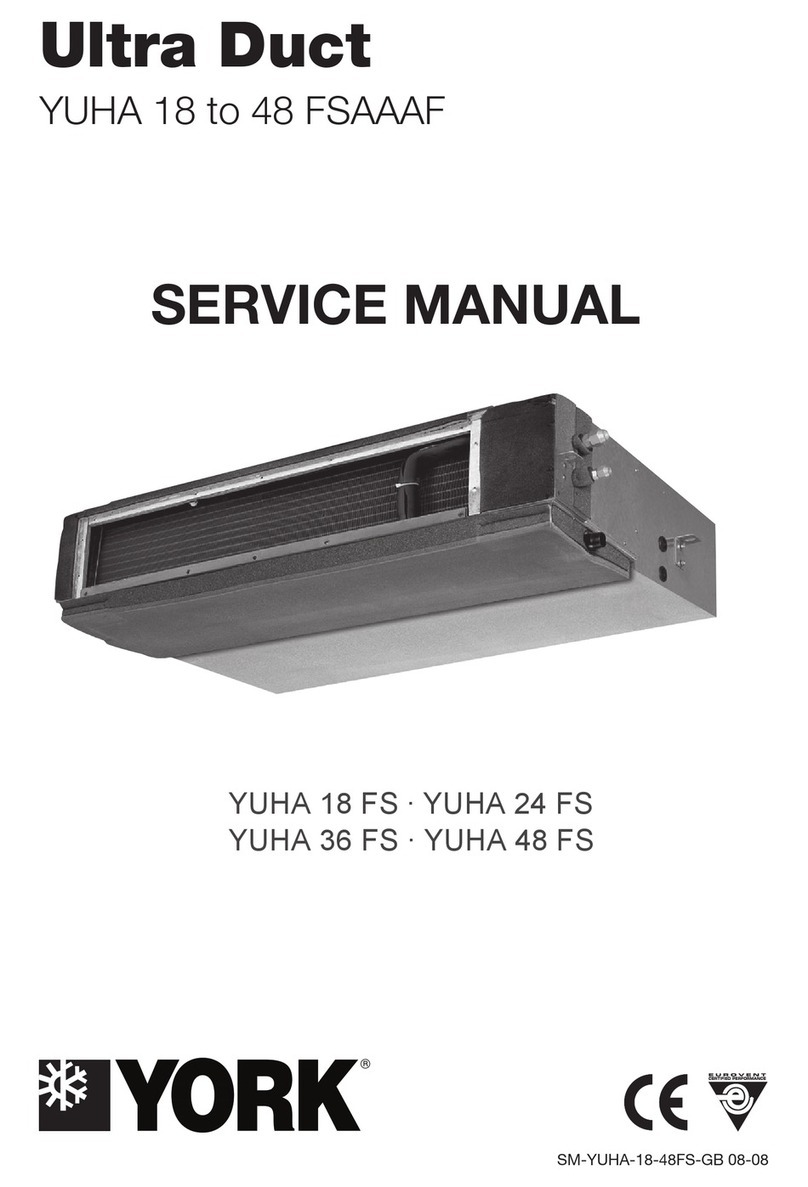
York
York YUHA 18 FS Service manual

Daikin
Daikin Super Multi Plus E-Series CTXG50EV1BW user manual
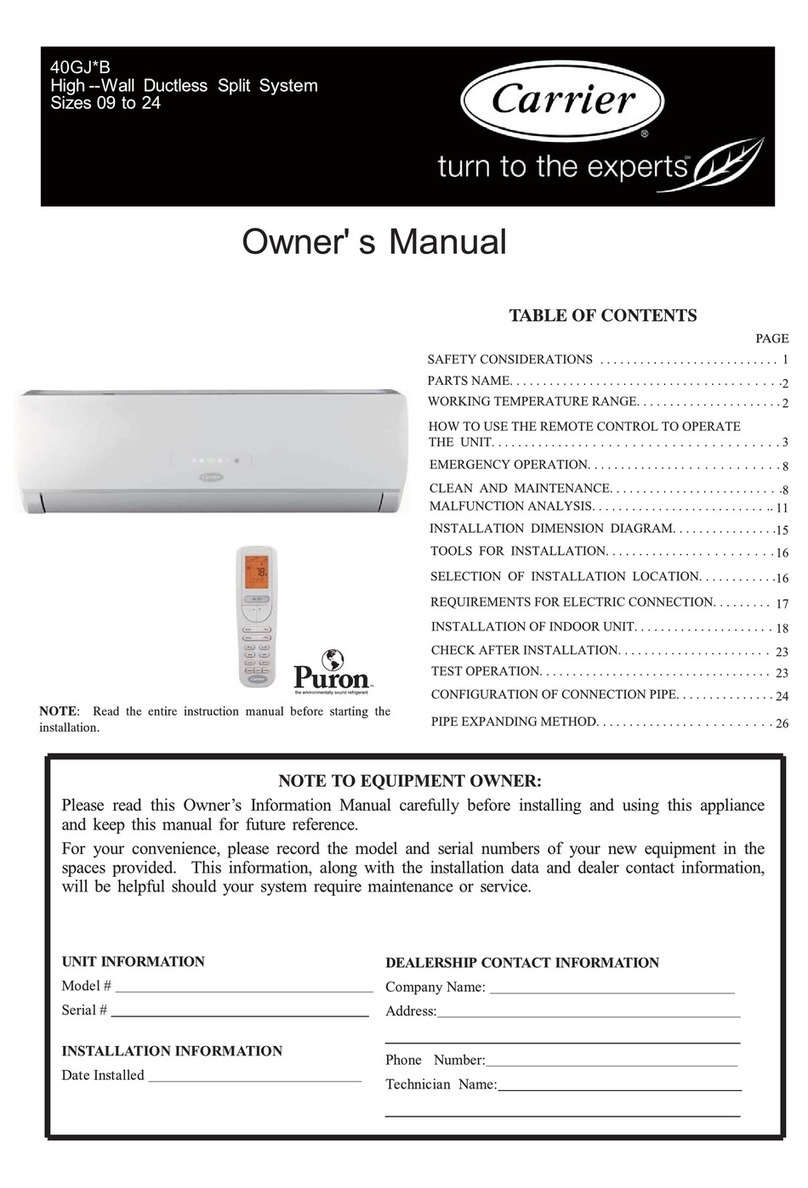
Carrier
Carrier 40GJB owner's manual

Cooler Master
Cooler Master Silent Pro Gold 450W user manual
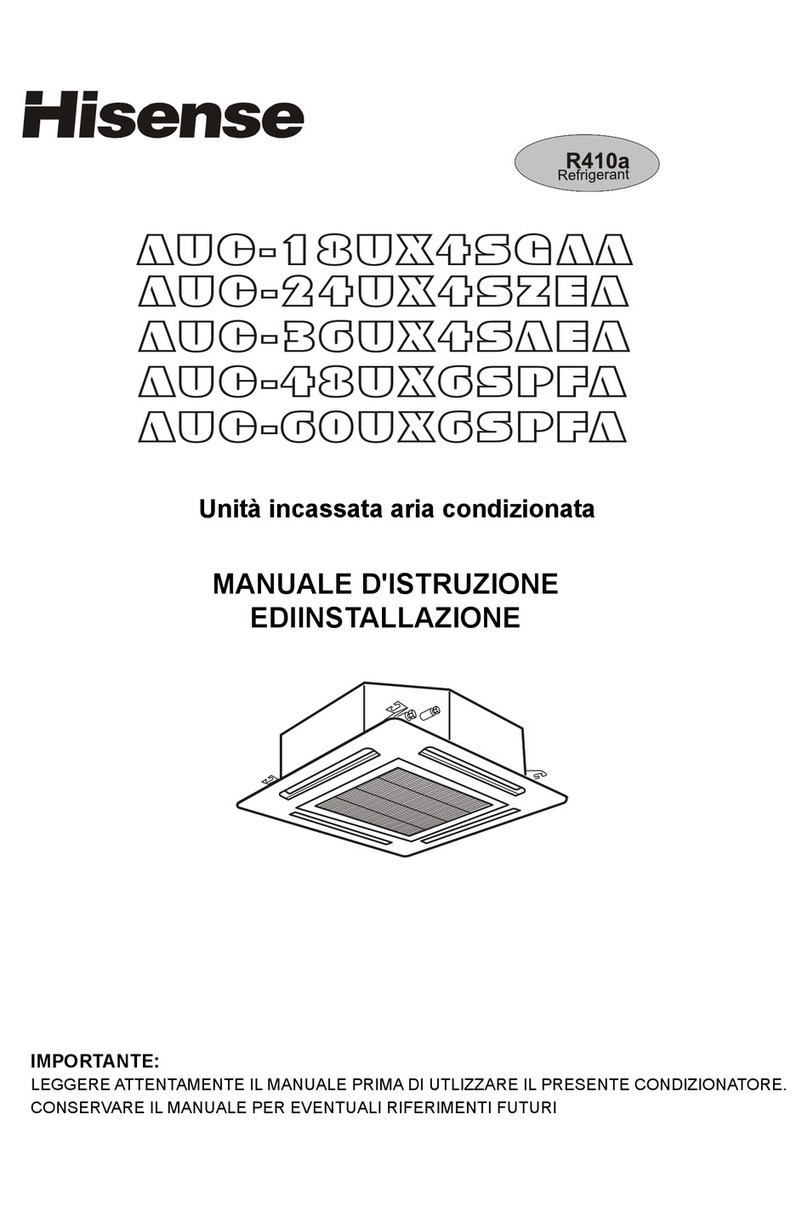
Hisense
Hisense AUC-18UX4SGAA Instruction and installation manual
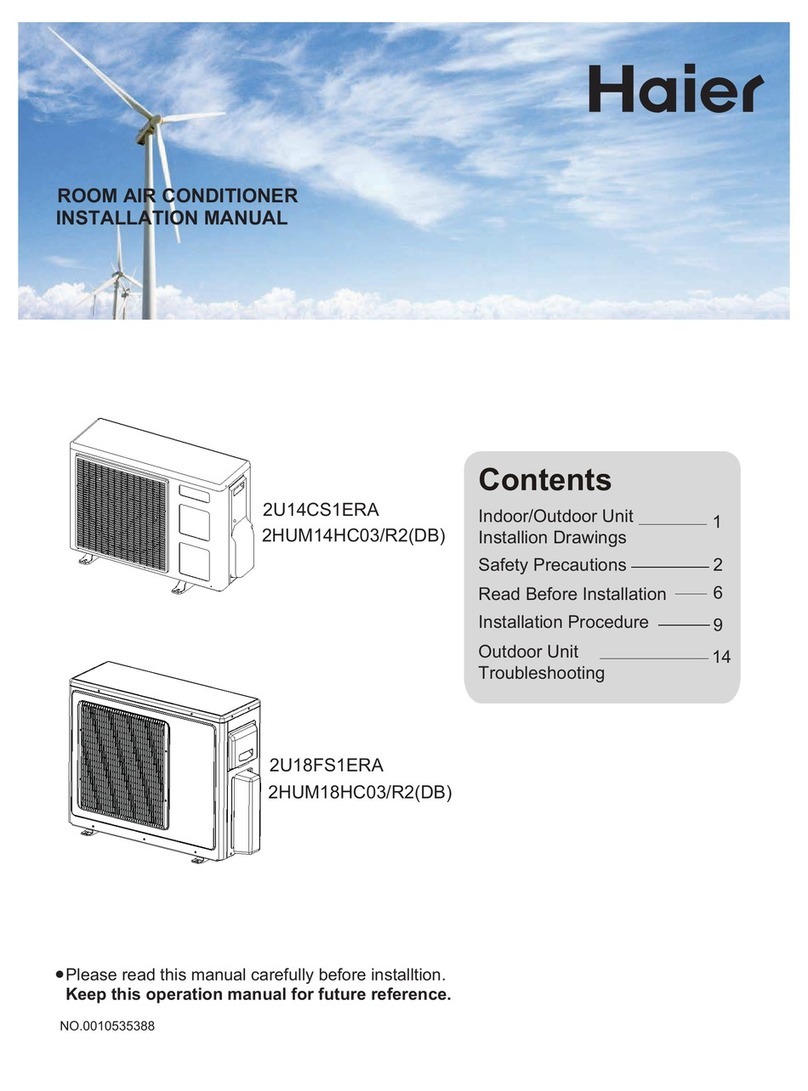
Haier
Haier 2HUM14HC03-R2 installation manual

Mitsubishi Electric
Mitsubishi Electric MS-GK36VAT operating instructions
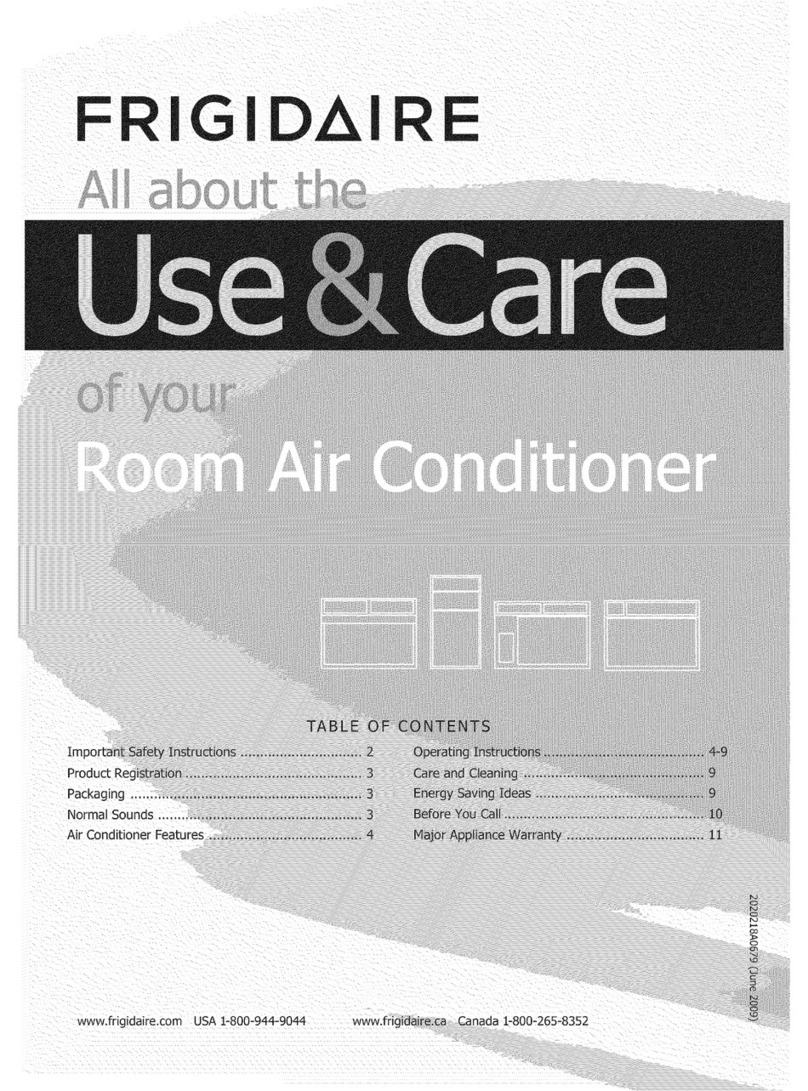
Frigidaire
Frigidaire LRA257ST21 Use & care guide

Shinco
Shinco SPF1-10C owner's manual
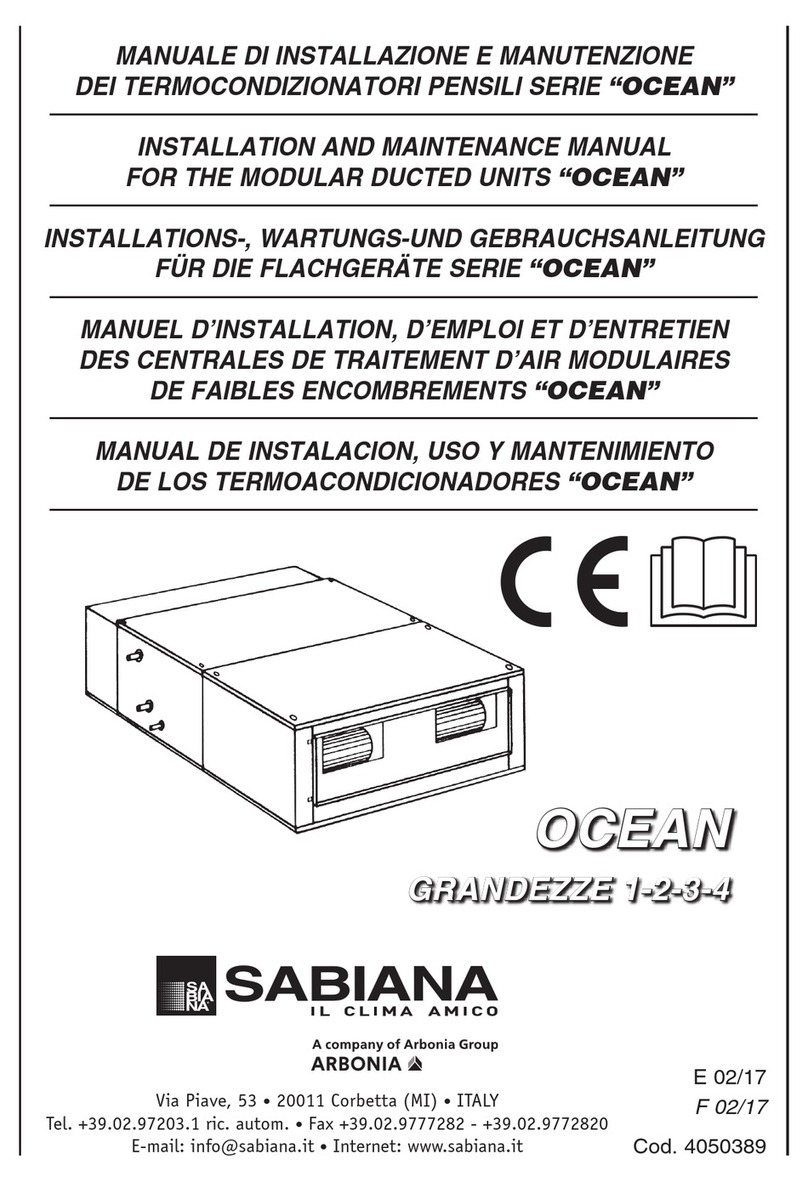
Arbonia
Arbonia SABIANA OCEAN Series Installation and maintenance manual
